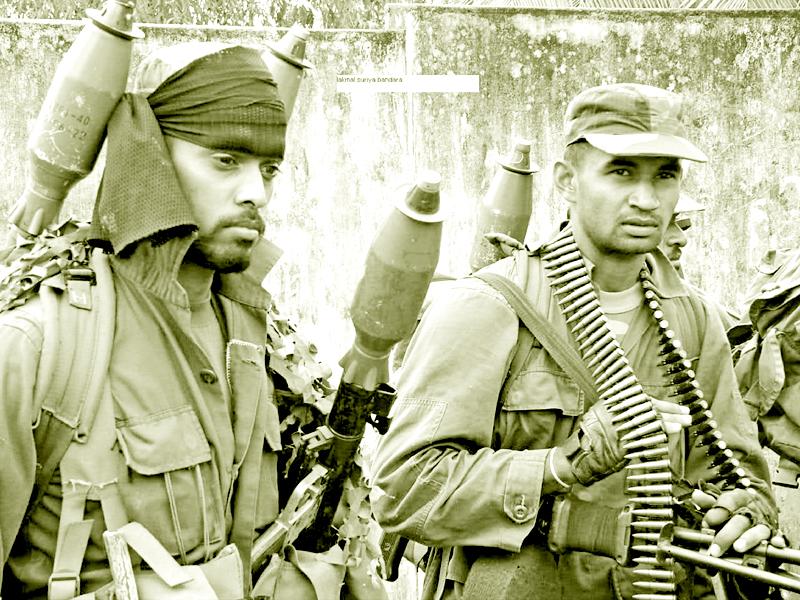
The military history of ancient Ceylon is laden with episodes of invasions and how they were repulsed with grit and valour. The first recorded such military engagement unfolded on the beaches with the arrival of the banished Prince Vijaya. Our ancient monarchs who excelled in the theatre of combat were King Dutugemunu, Gajabahu, Dhatusena and Vijayabahu. The legendary ruler, King Parakramabahu 1 mounted a major military sea borne offensive against Myanmar, using a detachment of elephant mounted troops whose presence had sent the enemy running in all directions. These ancient forces relied on cavalry and skilled archers. Subsequently, invading European forces managed to gain the upper hand by the use of cannons, and gradually captured our maritime provinces.
Though somewhat suppressed with this onslaught of rifles and cannons the Portuguese, Dutch and British faced stiff resistance and suffered heavy casualties from the tactical ambushes of the determined natives, who fought without fear. The Dutch later fortified their defences by erecting forts in Colombo, Matara, Jaffna, Galle, Trincomalee and Batticaloa. Later, the British established a military garrison at Trincomalee with a naval fleet.
Early formation
In 1802, a rifle regiment was formed with Sinhalese, African and Malay soldiers and named 1st Ceylon Regiment. In 1861, the colony of Ceylon was bestowed with her first Volunteer Corps. This formation was referred to as Ceylon Light Infantry Volunteers. Slowly but steadily, the army branched out to raise units such as, the Ceylon Artillery, Mounted Infantry, Medical Corps, Engineer Corps and Supply and Transport Corps. In 1910, the force was subject to effective combat readiness and renamed Ceylon Defence Force. The men were deployed to active duty in England. With the advent of the Second World War the defence force raised some new units including, Military Police Corps, Signal Corps and Colombo Town Guard. In 1949, the Army Act was passed in Parliament establishing the Ceylon Army. A regular force was formed on October 10 1949, under the command of Brigadier Roderick Sinclair. In 1950, the first batch of eager Ceylonese were sent to the Royal Military Academy Sandhurst, England, for training. Realizing the urgent need to train future cadets locally, the Army set up their first training school in the hills of Diyatalawa. The academy has blossomed into a degree awarding institution and has produced many Generals since then. At the age of 47, Brigadier Anton Muthukumaru became the first Sri Lankan Commander of the Army. He was the dynamic visionary who began establishing the cantonment at Panagoda. The Women’s Corps was formed in 1979. In the years that followed our motherland was subject to home grown insurgencies and violent domestic terrorism, which made the army establish area headquarters.
The first commando course was conducted in February 1978, and the commando squadron formed in 1980. During the course of the prolonged 30 year conflict the army adopted and adjusted to various levels of threats incorporating technology and enhanced training. In the final stages of the humanitarian operations in 2009, the Infantry regiments, Special Forces, Armoured Corps, Air Mobile Brigade, Artillery and Mechanized Infantry units all contributed, with many laying down their lives in the line of duty.
Forward March
In this era of sustained peace, the army according to its present Commander Lt.General Mahesh Senanayake is taking the dimension of a capacity based force. In the recent past when the country was assailed by natural disasters it was the troops who actively engaged in rescue operations as first responders. Whether it was the relentless rains which unleashed floods and landslides or a collapsed high rise building, the Sri Lankan soldier was again willing to display his spirit of altruism, in saving others. It was the ordinary soldier who reached out with the arm of assurance and friendship to people who had lost everything.
The army can be applauded for setting up medical clinics, water purifying stations and food processing units to care for those in times of dire need. Even to this date in the Northern Province the army plays a pivotal role in helping the public in many areas. These silent contributions include demining operations and facilitating the return of people to their ancestral lands, painting and repairing of schools, hospitals and places of religious worship, organizing sports events for youth, providing books and computers to selected schools and celebrating local religious festivals with communities.
In the area of regional security and inter-operability of forces the army has conducted the Colombo Defence Seminar, with the participation of many foreign military service chiefs and military analysts, where current security issues of the region were deliberated. In keeping our forces primed and ready, the annual field training exercise “Cormorant Strike” was successfully concluded for the 8th time in the Eastern Province using members of the Commando and Special Forces along with the SLAF and SLN. These mock missions also had foreign troops as observers.
In view of celebrating their anniversary, the army conducted religious observances in keeping with the Buddhist, Christian, Islam and Hindu traditions, with the participation of senior officers. The Army is a fine example where officers and ranks from the Sinhala, Tamil, Muslim and Burgher communities unite as one fraternity to serve the motherland. The military will continue to play an important role as we make progress towards greater prosperity for all Sri Lankans.
